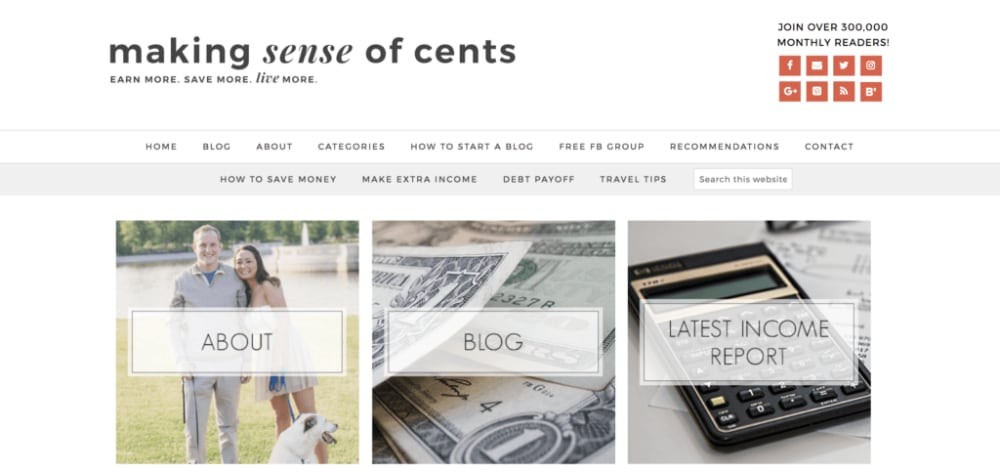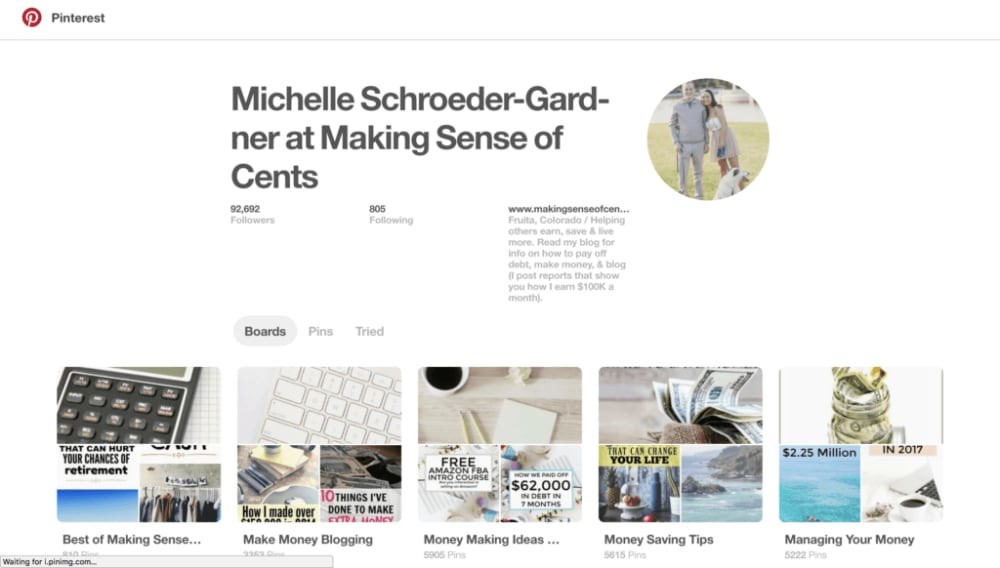What you will learn
- How Michelle generates 100k+ traffic from Pinterest per month
- Why Pinterest is such a good platform for affiliate marketers
- Why revenue stacking makes your business more secure
- How affiliate marketing can still provide value years down the line
In this week’s podcast Perrin is joined by Michelle Schroeder Gardner from Making Sense of Cents.
Michelle launched the site back in 2011 as a way of documenting her struggles with student loan debt. She was living from paycheck to paycheck. Making Sense of Cents was intended to share what Michelle learned as she was trying to work out how she would pay her student loans off.
Fast forward to 2017 and Making Sense of Cents is on track to make over $1.5 million this year.
In today’s episode, Michelle is going to share some of the secrets behind growing a 7 figure website.
What is Making Sense of Cents?

Although Making Sense of Cents is predominantly a personal finance blog, Michelle writes about anything she is interested in or that is related to her life.
Michelle talks about:
- Making money
- Saving money
- Your dream life – so this means talking about confidence and being successful
- Travelling full time
- Making money blogging
The site was launched all the way back in the summer of 2011. Michelle’s goals for the site were to teach people how to save money and journal her own finances.
At this point, Michelle was writing the blog anonymously. She had no idea that you could make money blogging. In fact, she didn’t really know what a blog was at all.
After completing a Finance MBA, Michelle was left with $38k of student debt. If you look at the blog back then, you will find a lot of posts on student debts and you will even find Michelle pondering whether or not to get a second job to tackle these debts.
However, after around six months of blogging, Michelle soon realized that she could make money from the blog itself. A blogger friend got in touch and asked if a company that they worked with could place a sponsored post on Making Sense of Cents for $100. This was the first money that the site made.
In this first year, Michelle estimates that she probably made around $1k from the site, total.
After this first year, the site began to grow quite quickly. By October 2013, Michelle has left her job to become a full-time blogger and the site was making $10k per month.
Last year, in 2016, Making Sense of Cents made $976k and the site is on track to make $1.5-1.75m this year.
You market and make money in lots of different ways, tell us about your success in getting traffic from Pinterest.

Michelle gets a lot of traffic from Pinterest. Perrin has previously discussed Pinterest on the podcast with Kate Ahl. It can be a great way to get a lot of traffic for authority sites.
Here are some of the stats on Michelle’s most popular posts on Pinterest:
Michelle’s basic strategy for Pinterest is as follows:
- 30+ ways to save money each month – 51k pins
- How to make an extra $1k per month – 69k pins
- How to live on one income – 73k pins
- 75 ways to make extra money – 104k pins
- My student loans are finally fully paid off – 105k pins
For Kate, the purpose of Pinterest is to drive traffic back to the blog. She doesn’t place affiliate links on Pinterest as some others do but they do promote the signup page for a free “how to start a blog” email course.
At the moment, Making Sense of Cents is getting anywhere in the region of 100-300k visits per month from Pinterest.
When they do come to the blog, Michelle tries to get them to sign up for the email list or to read an article with affiliate links within it.
Michelle also has an affiliate marketing course. She sees Pinterest as a crucial platform for affiliate marketers. The main reason for this is that people go onto Pinterest to buy or look at things that they are interested in buying. In Michelle’s opinion, there is no social media platform with more buyers than Pinterest.
Pinterest can also be effective for smaller bloggers. This is because Pinterest traffic is not dependant upon follower. They have a smart formula for putting content in front of users that shows the users content that is interesting to them. Michelle rates Pinterest as one of the main sources of traffic for a new blogger.
- Write a blog post (Michelle doesn’t think about Pinterest at this point)
- Create a Pinterest friendly image (Long, thin images work best)
- Create a great headline
- Write a great description that sounds as though you are talking to a friend
- Use Boardbooster to loop popular pins to boards and group boards
- Use Tailwind App for automation
Revenue Stacking – Why do you monetize in so many different ways?
Michelle first started making money through sponsored posts and display ads. This can be a great source of income but the problem is that it is not always consistent from month to month.
This led to Michelle seeking out other sources of income so that she was not reliant upon a single source. It also means that if Michelle loses 50% of her ad income, she does not lose 50% of her overall income.
From there, Michelle started looking at affiliate income. The benefits are that is easy to promote products that you love, all you have to do is include a link in your post or write a review. It also is very passive. You can write an article and still earn money years down the line.

For a newer blogger, Michelle would recommend choosing no more than three affiliate programs to begin with. The best way to do this it to find products that you are using and find an affiliate program or to ask your existing audience what products they are interested in.
The final way Michelle monetizes is through products. After being successful in her affiliate marketing efforts, Michelle decided to launch an online course teaching people how to do affiliate marketing her way.
Michelle loves having her own product as it gives her control over everything. The downside here is that you actually have to manage everything.
Rapid Fire – What is the Difference Between the Following for a Small and a Big Blog?
SEO
Michelle doesn’t do a lot of SEO but she does focus on creating real relationships, guest posting and gathering links naturally. In her mind, this is the same for a small blog or a big blog.
Social Media
For small blogs, it can be a lot more difficult to gain that initial traction but there is where Pinterest can come in. For a smaller blog, Michelle would recommend Pinterest whereas the bigger blogs can look further afield and look to grow their Facebook page into a powerful traffic source.
Products
Products are easier to launch for a larger site but if a smaller blog has a loyal following, products can also be successful here.
Hiring
Michelle wished she had hired sooner. It makes sense to outsource things and it really held Michelle back at one point before she made her first hire that she insisted on doing everything herself.
Lifestyle
This is a difficult one to answer. For a smaller blog, you have to work a lot to build it up and you do not necessarily have the money to hire people. This means you are doing everything yourself.
For a larger site, it is a lot of work. However, by this point, you should have enough money coming in to go and hire people. When you become a really big site, you can actually hire people to manage the site most of the time. In fact, at the moment, Michelle is only working around 10 hours per week.
The work/ life balance really depends upon how much you outsource and how much you do yourself. It is less about the size of the site.
Conclusion
If you want to hear more from Michelle, you can find her over at Making Sense of Cents. You can also find her affiliate marketing course at Making Sense of Affiliate Marketing or her free email course here.





